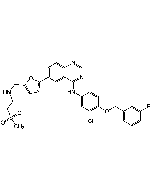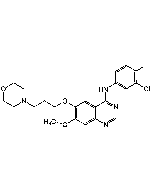Cookie Policy: This site uses cookies to improve your experience. You can find out more about our use of cookies in our Privacy Policy. By continuing to browse this site you agree to our use of cookies.
SynKinase
Pelitinib
CHF 0.00
In stock
SYN-1141-M0011 mgCHF 114.00
SYN-1141-M0055 mgCHF 170.00
SYN-1141-M01010 mgCHF 298.00
SYN-1141-M05050 mgCHF 1'015.00
SYN-1141-M100100 mgINQ

| Product Details | |
|---|---|
| Synonyms | EKB-569 |
| Product Type | Chemical |
| Properties | |
| Formula | C24H23ClFN5O2 |
| MW | 467.9 |
| CAS | 257933-82-7 |
| Purity Chemicals | ≥95% |
| Appearance | Solid. |
| Solubility | Soluble in DMSO or ethanol. |
| Declaration | Manufactured by SynKinase. |
| Other Product Data |
Target: EGFR - HER2 | Kinase Group: RTK | Substrate: Tyrosine Click here for Original Manufacturer Product Datasheet Our product description may differ slightly from the original manufacturers product datasheet. |
| InChi Key | WVUNYSQLFKLYNI-AATRIKPKSA-N |
| Shipping and Handling | |
| Shipping | AMBIENT |
| Short Term Storage | +4°C |
| Long Term Storage | -20°C |
| Use/Stability | Stable for at least 2 years after receipt when stored at -20°C. |
| Documents | |
| MSDS |
 Download PDF Download PDF |
| Product Specification Sheet | |
| Datasheet |
 Download PDF Download PDF |
Description
Pelitinib, also known as EKB 569, is a potent, irreversible inhibitor of the EGFR tyrosine kinase. Cell based IC(50) values range from 39nM to 80nM and in vitro kinase assays are in sub-nanomolar range for EGFR receptors. In xenograft tumor models using overexpressing A431 cells Pelitinib inhibits growth of tumors with effective doses of 3.5-10mg/kg/dl. Recent research also shows that Pelitinib can potentiate radiation induced killing of squamouse cell carcinoma via the inhibition of IR-induced NF-κB mediated cell survial pathway.
Product References
- Dual irreversible kinase inhibitors: quinazoline-based inhibitors incorporating two independent reactive centers with each targeting different cysteine residues in the kinase domains of EGFR and VEGFR-2: A. Wissner, et al.; Bioorg. Med. Chem. 15, 3635 (2007)
- A quantitative analysis of kinase inhibitor selectivity: M.W. Karaman, et al.; Nat. Biotechnol. 26, 127 (2008)
- Development of a new epidermal growth factor receptor positron emission tomography imaging agent based on the 3-cyanoquinoline core: synthesis and biological evaluation: F. Pisaneschi, et al.; Bioorg. Med. Chem. 18, 6634 (2010)









